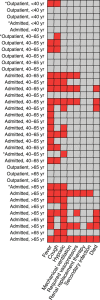Characteristics and Outcomes of COVID-19 in Patients on Left Ventricular Assist Device Support
- PMID: 33813838
- PMCID: PMC8059761
- DOI: 10.1161/CIRCHEARTFAILURE.120.007957
Characteristics and Outcomes of COVID-19 in Patients on Left Ventricular Assist Device Support
Abstract
Background: The coronavirus disease 2019 (COVID-19) pandemic continues to afflict millions of people worldwide. Patients with end-stage heart failure and left ventricular assist devices (LVADs) may be at risk for severe COVID-19 given a high prevalence of complex comorbidities and functional impaired immunity. The objective of this study is to describe the clinical characteristics and outcomes of COVID-19 in patients with end-stage heart failure and durable LVADs.
Methods: The Trans-CoV-VAD registry is a multi-center registry of LVAD and cardiac transplant patients in the United States with confirmed COVID-19. Patient characteristics, exposure history, presentation, laboratory data, course, and clinical outcomes were collected by participating institutions and reviewed by a central data repository. This report represents the participation of the first 9 centers to report LVAD data into the registry.
Results: A total of 40 patients were included in this cohort. The median age was 56 years (interquartile range, 46-68), 14 (35%) were women, and 21 (52%) were Black. Among the most common presenting symptoms were cough (41%), fever, and fatigue (both 38%). A total of 18% were asymptomatic at diagnosis. Only 43% of the patients reported either subjective or measured fever during the entire course of illness. Over half (60%) required hospitalization, and 8 patients (20%) died, often after lengthy hospitalizations.
Conclusions: We present the largest case series of LVAD patients with COVID-19 to date. Understanding these characteristics is essential in an effort to improve the outcome of this complex patient population.
Keywords: COVID-19; SARS-CoV-2; heart failure; hospitalization; outcomes research; ventricular assist device.
Figures



References
-
- World Health Organization. WHO Director-General’s opening remarks at the media briefing on COVID-19 - 11 March 2020. https://www.who.int/dg/speeches/detail/who-director-general-s-opening-re.... Accessed July 4, 2020
-
- World Health Organization. Coronavirus disease (COVID-19) – World Health Organization. https://www.who.int/emergencies/diseases/novel-coronavirus-2019. Accessed November 2, 2020
Publication types
MeSH terms
Grants and funding
LinkOut - more resources
Full Text Sources
Other Literature Sources
Medical
Miscellaneous

